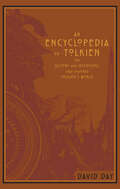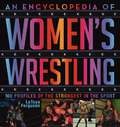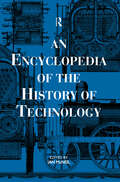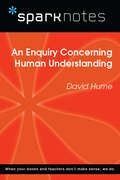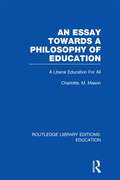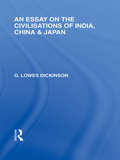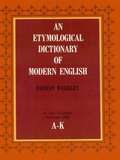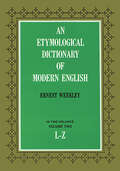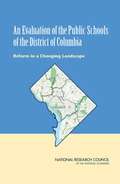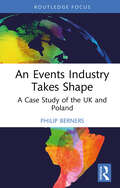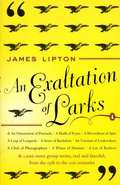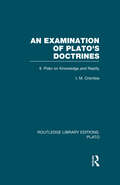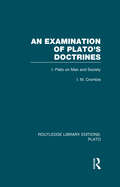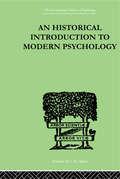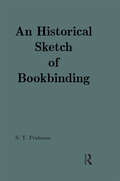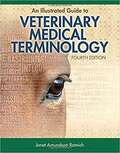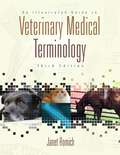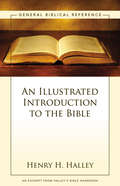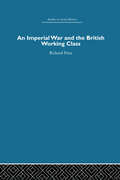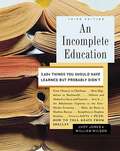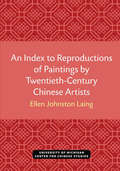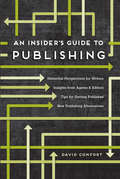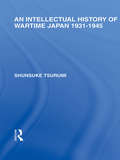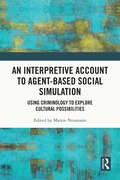- Table View
- List View
An Encyclopedia of Tolkien: The History and Mythology That Inspired Tolkien's World (Leather-bound Classics)
by David DayA comprehensive, illustrated guide to the history, lands, and inhabitants of Middle-earth. The fantasy world of J. R. R. Tolkien’s Middle-earth contains a rich assortment of people, cities, and creatures—as well as a deep, intertwined history that spans thousands of years. In this beautifully illustrated volume, best-selling author and Tolkien scholar David Day presents four decades of research and writing on the lands and inhabitants Middle-earth. Sections of this A-to-Z dictionary are devoted to discussion of the battles, history, beasts, and heroes of Tolkien’s stories. This comprehensive volume on Tolkien’s world also includes an appendix of three primary legends that served as sources for Tolkien’s creations—the Volsunga saga, the Nibelungenlied, and Richard Wagner’s Ring Cycle—and more than 200 black-and-white illustrations
An Encyclopedia of Women's Wrestling: 100 Profiles of the Strongest in the Sport
by LaToya FergusonA comprehensive and fascinating illustrated look at women&’s professional wrestling, including 100 profiles of superstars from around the world. Women&’s pro wrestling has existed in the USA since the 1930s, and this colorful encyclopedia references the fashion, fun, and drama of the sport through the years and around the world. Focusing on 100 competitors—from current faves Sasha Banks and Charlotte Flair, to Germany's Jazzy Gabert, Japan&’s Io Shirai, and Canada's LuFisto, to legends like The Fabulous Moolah, Sable, Ivory, and Lita—it includes relevant stats and each one&’s compelling story. Written by noted authority LaToya Ferguson, this engaging history is great for anyone interested in powerful women, fantastic costumes, and pro wrestling itself.
An Encyclopedia of the History of Technology (Routledge Companion Encyclopedias)
by Ian McNEIL* 22 sections cover the entire field of the history of technology and each section summarises the development of its subject from the earliest times to the present day* Written without unnecessary jargon* 2 extensive indexes of Names and Topics* Usefully illustrated with 150 black & white photographs and line drawings to explain key advances`Contain[s] a vast amount of reliable information over a very wide field. It is certainly a work of which I shall myself make frequent use ... it deserves to find a place ... in every reference library.' - Times Higher Education Supplement`The coverage is excellent ... a most valuable single-volume source which for its comprehensiveness and ease of reference will earn its place in both specialist and general reference collections.' - Reference Reviews`Informative and comprehensive, remarkable in its coverage ... covers every aspect of technology from the Stone Age to the Space Age ... will undoubtedly help readers to get a grip on and feel of an enormous range of subjects ... An invaluable and practical addition to most office bookshelves or libraries.' - New Civil Engineer`The authors represented in this book are to be congratulated for their readable and reliable surveys of the past and present status of the major areas where mankind has harnessed science for the production of useful products and processes.' - Choice
An Enquiry Concerning Human Understanding (SparkNotes Philosophy Guide)
by SparkNotesAn Enquiry Concerning Human Understanding (SparkNotes Philosophy Guide) Making the reading experience fun! SparkNotes Philosophy Guides are one-stop guides to the great works of philosophy–masterpieces that stand at the foundations of Western thought. Inside each Philosophy Guide you&’ll find insightful overviews of great philosophical works of the Western world.
An Essay Towards A Philosophy of Education: A Liberal Education for All (Routledge Library Editions: Education)
by Charlotte M MasonThis was the last and most important and comprehensive work of Charlotte Mason, (founder of the Parents’ National Educational Union). For more than half a century the practical results of her original thought on education could be seen in all parts of the world in the Charlotte Mason Method and the Parents’ Union Schools.
An Essay on the Civilisations of India, China and Japan (Routledge Library Editions: Japan)
by G Lowes DickinsonThis volume presents an account of the author’s travels during 1912-13 making particular note of the characteristics of Indian, Chinese and Japanese societies and the effect upon them of contact with the West. Although inevitably dated in some of its views, the volume nonetheless provides an excellent starting point for comparisons between East and West and the strengths and weaknesses of the individual cultures, be it in politics, literature or the arts.
An Etymological Dictionary of Modern English, Vol. 1 (Dover Language Guides #1)
by Ernest WeekleyThe compiler of this dictionary of word and phrase origins and history was not only a linguist and a philologist but also a man of culture and wit. When he turned his attention, therefore, to the creation of an etymological dictionary for both specialists and non-specialists, the result was easily the finest such work ever prepared.Weekley's Dictionary is a work of thorough scholarship. It contains one of the largest lists of words and phrases to be found in any singly etymological dictionary -- and considerably more material than in the standard concise edition, with fuller quotes and historical discussions. Included are most of the more common words used in English as well as slang, archaic words, such formulas as "I. O. U.," made-up words (such as Carroll's "Jabberwock"), words coined from proper nouns, and so on. In each case, roots in Anglo-Saxon, Old Norse, Greek or Latin, Old and modern French, Anglo-Indian, etc., are identified; in hundreds of cases, especially odd or amusing listings, earliest known usage is mentioned and sense is indicated in quotations from Dickens, Shakespeare, Chaucer, "Piers Plowman," Defoe, O. Henry, Spenser, Byron, Kipling, and so on, and from contemporary newspapers, translations of the Bible, and dozens of foreign-language authors.
An Etymological Dictionary of Modern English, Vol. 2 (Dover Language Guides #2)
by Ernest WeekleyThe compiler of this dictionary of word and phrase origins and history was not only a linguist and a philologist but also a man of culture and wit. When he turned his attention, therefore, to the creation of an etymological dictionary for both specialists and non-specialists, the result was easily the finest such work ever prepared.Weekley's Dictionary is a work of thorough scholarship. It contains one of the largest lists of words and phrases to be found in any singly etymological dictionary -- and considerably more material than in the standard concise edition, with fuller quotes and historical discussions. Included are most of the more common words used in English as well as slang, archaic words, such formulas as "I. O. U.," made-up words (such as Carroll's "Jabberwock"), words coined from proper nouns, and so on. In each case, roots in Anglo-Saxon, Old Norse, Greek or Latin, Old and modern French, Anglo-Indian, etc., are identified; in hundreds of cases, especially odd or amusing listings, earliest known usage is mentioned and sense is indicated in quotations from Dickens, Shakespeare, Chaucer, "Piers Plowman," Defoe, O. Henry, Spenser, Byron, Kipling, and so on, and from contemporary newspapers, translations of the Bible, and dozens of foreign-language authors.
An Evaluation of the Public Schools of the District of Columbia: Reform in a Changing Landscape
by Committee for the Five-Year (2009-2013) Summative Evaluation of the District of Columbia Public SchoolsAn Evaluation of the Public Schools of the District of Columbia is a comprehensive five-year summative evaluation report for Phase Two of an initiative to evaluate the District of Columbia's public schools. Consistent with the recommendations in the 2011 report A Plan for Evaluating the District of Columbia's Public Schools, this new report describes changes in the public schools during the period from 2009 to 2013. An Evaluation of the Public Schools of the District of Columbia examines business practices, human resources operations and human capital strategies, academic plans, and student achievement. This report identifies what is working well seven years after legislation was enacted to give control of public schools to the mayor of the District of Columbia and which areas need additional attention.
An Events Industry Takes Shape: A Case Study of the UK and Poland
by Philip BernersThis timely book critically evaluates the factors which shape an events industry as it develops, with the aim of helping to narrow the disparate behaviours and practices of organisers within the global marketplace of international events.Stemming from an innovative qualitative research project, which included interviews with senior events organisers at landmark venues in both the UK and Poland, this volume provides an insight into both the emerging events industry in Poland and the developed events industry in the UK, highlighting cross-cultural risk and safety gaps that may impact organisers, clients, attendees, suppliers, and workers. The book highlights the importance of a unanimous global approach to events organisation, the creation of a professional community of practice, and ethos of self-learning within the events industry and the need for an international professional association for organisers involved with providing international events. The book explores the three themes of 'Event Culture', 'Tourism and Events', and 'Risk Awareness at Events', thus focusing on long-term factors of events industries.International in scope, this book will appeal to students on courses such as managing events, planning events, project management, and hospitality and tourism studies, as well as events organisers in locations where events is an emerging industry.
An Exaltation of Larks: The Ultimate Edition
by James LiptonIf you've ever wondered whether familiar terms like "a pride of lions" or "a string of ponies" were only the tip of a linguistic iceberg, An Exaltation of Larks provides the definitive answer. This classic collection of collective nouns includes more than 1,100 equally pithy, and often poetic, terms - some resurrected from the Books of Venery that were the constant study of fifteenth-century gentlemen; some ("a blur of Impressionists," "a score of bachelors") more recently minted. Here too is a game for readers inspired to invent their own "terms of venery. " Infectious in spirit and beautifully illustrated with more than 250 witty engravings, An Exaltation of Larks is a word-lover's garden of delights.
An Examination of Plato's Doctrines Vol 2: Volume 2 Plato on Knowledge and Reality (Routledge Library Editions: Plato)
by I M CrombieIan Crombie’s impressive volumes provide a comprehensive interpretation of Plato’s doctrines. Volume 2 deals with more technical philosophical topics, including the theory of knowledge, philosophy of nature, and the methodology of science and philosophy. Each volume is self-contained.
An Examination of Plato's Doctrines: Volume 1 Plato on Man and Society (Routledge Library Editions: Plato)
by I M CrombieIan Crombie’s impressive volumes provide a comprehensive interpretation of Plato’s doctrines. Volume 1 contains topics of more general interest and is mainly concerned with what Plato has to say in the fields of moral philosophy, political philosophy, the philosophy of mind and the philosophy of religion.
An Historical Introduction To Modern Psychology (International Library Of Psychology Ser.)
by Murphy, GardnerFirst published in 1999. Routledge is an imprint of Taylor & Francis, an informa company.
An Historical Sketch of Bookbinding
by Sarah T. PrideauxAn Historical Sketch Of Bookbinding is a part of ‘The History of Bookbinding Technique and Design’-A series of reprint volumes, original monographs, and translations relating to the history of bookbinding. The chief part of the present book was written as an Introduction to the Catalogue of the Exhibition of Bindings, held at the Burlington Fine Arts Club in the Summer of 1891. Includes an appendix of a detailed account of embroidered covers, metal ornaments and book-edge decoration from the ‘Magazine of Art.’
An Illustrated Guide to Veterinary Medical Terminology
by Janet Amundson RomichProviding the ultimate terminology reference for veterinary assistants and technicians, AN ILLUSTRATED GUIDE TO VETERINARY MEDICAL TERMINOLOGY, 4e provides an engaging, systematic approach to learning medical terms and understanding basic principles of veterinary medicine. This user-friendly textbook delivers a unique pedagogical presentation that makes it a comprehensive learning resource. Focusing on how medical terms are formed, analyzed, and defined, the text discusses anatomical landmarks, the positioning of animals, and the relationships between body parts. It also introduces terms used in the animal industry. Case studies illustrate how medical terminology is experienced in real-world practice, and an audio wordlist enables readers to hear the terms they are learning.
An Illustrated Guide to Veterinary Medical Terminology (3rd edition)
by Janet Amundson RomichA systematic approach to breaking down the parts of medical terms is used, allowing readers to grasp basic medical concepts and apply critical thinking skills when faced with new and unfamiliar medical terminology.
An Illustrated Introduction to the Bible: A Zondervan Digital Short
by Henry H. HalleyDerived from Halley’s Bible Handbook, a world-renowned, accessible guide to the Bible now in its twenty-fifth edition, this digital short explains simply and clearly how the Bible was written and what it is about. Readers looking for a basic introduction to the Bible or wanting a tool to teach others about it will find An Illustrated Introduction to the Bible to be a handy resource.
An Imperial War and the British Working Class: Working-Class Attitudes and Reactions to the Boer War, 1899-1902
by Richard PriceFirst published in 2006. Routledge is an imprint of Taylor & Francis, an informa company.
An Incomplete Education: 3,684 Things You Should Have Learned but Probably Didn't
by Judy Jones William WilsonWhen it was originally published in 1987, An Incomplete Education became a surprise bestseller. Now this instant classic has been completely updated, outfitted with a whole new arsenal of indispensable knowledge on global affairs, popular culture, economic trends, scientific principles, and modern arts. Here’s your chance to brush up on all those subjects you slept through in school, reacquaint yourself with all the facts you once knew (then promptly forgot), catch up on major developments in the world today, and become the Renaissance man or woman you always knew you could be! How do you tell the Balkans from the Caucasus? What’s the difference between fission and fusion? Whigs and Tories? Shiites and Sunnis? Deduction and induction? Why aren’t all Shakespearean comedies necessarily thigh-slappers? What are transcendental numbers and what are they good for? What really happened in Plato’s cave? Is postmodernism dead or just having a bad hair day? And for extra credit, when should you use the adjective continual and when should you use continuous? An Incomplete Education answers these and thousands of other questions with incomparable wit, style, and clarity. American Studies, Art History, Economics, Film, Literature, Music, Philosophy, Political Science, Psychology, Religion, Science, and World History: Here’s the bottom line on each of these major disciplines, distilled to its essence and served up with consummate flair. In this revised edition you’ll find a vitally expanded treatment of international issues, reflecting the seismic geopolitical upheavals of the past decade, from economic free-fall in South America to Central Africa’s world war, and from violent radicalization in the Muslim world to the crucial trade agreements that are defining globalization for the twenty-first century. And don’t forget to read the section A Nervous American’s Guide to Living and Loving on Five Continents before you answer a personal ad in the International Herald Tribune. As delightful as it is illuminating, An Incomplete Education packs ten thousand years of culture into a single superbly readable volume. This is a book to celebrate, to share, to give and receive, to pore over and browse through, and to return to again and again.
An Index to Reproductions of Paintings by Twentieth-Century Chinese Artists (Michigan Monographs In Chinese Studies #76)
by Ellen Johnston LaingIn the second half of the twentieth century, studies in Chinese painting history have been greatly aided by several major lists of Chinese artists and their works. Published between 1956 and 1980, these lists were limited to Imperial China. The current index covers the period from 1912 to around 1980. It includes the names of approximately 3,500 traditional-style artists along with lists of their works, reproduced in some 264 monographs, books, journals, and catalogs published from the 1920s to around 1980. With a few exceptions, artists working after 1949 outside continental China are excluded. Revised Edition, 1998; first published by the Asian Studies Program, University of Oregon, 1984.
An Indoor Air Quality Management Framework for Municipal Buildings in Developing Economies (Routledge Research Collections for Construction in Developing Countries)
by Clinton Ohis Aigbavboa Wellington Didibhuku Thwala Abdul-Majeed Mahamadu Mpho NdouThis book delves into the pivotal issue of Indoor Air Quality (IAQ) management in municipal buildings within developing economies, addressing a pressing need in today’s digital age, where individuals spend over 70% of their time indoors. With a strong focus on enhancing environmental quality, this book presents theoretical frameworks and practical recommendations designed explicitly for stakeholders in the higher education sector, encompassing both public and private institutions.As institutions strive to improve their learning environments, this book aligns with global Sustainable Development Goals (SDGs), highlighting the vital connection between effective IAQ management and the health and well-being of the institutional community, including students and staff members. It provides a comprehensive framework that advocates for improved IAQ management and emphasises the importance of quality education and lifelong learning.Furthermore, this book serves as a valuable resource for green building regulatory bodies, ensuring adherence to best practices in IAQ management within municipal buildings. By providing actionable strategies grounded on recent literature, the book is an essential guide for researchers and policymakers seeking to navigate the theoretical and empirical dimensions of IAQ management. Moreover, this book asserts that enhancing IAQ is necessary not only for regulatory compliance and community well-being but also as a vital investment in the academic and operational success of municipal buildings in developing economies.
An Insider's Guide to Publishing
by David Comfort"PERSEVERANCE IS MUCH MORE IMPORTANT THAN TALENT. BECAUSE SO MANY TALENTED PEOPLE FALL BY THE WAYSIDE"--James MichenerThe history of writing is full of authors striving to succeed in a hyper-competetive publishing world, contending with agents, editors, publishers, critics, and sometimes the greatest challenge of all - overnight success. For all of the extaordinary changes that have recently taken place, however, there are a few things that remain the same. Getting published still requires persistence, preparation, and smarts, as well as an understanding of how the business works, where it's been, and where it's going.An Insider's Guide to Publishing pulls back the industry curtain for millions of published and aspiring authors, revealing Hemingway's famous feuds, Poe's raving madness, Capote's vengeful wit, and much more. With clever insights and dark humor to spare, David Comfort, a thirty-year veteran of the publishing trenches, explores the achivements and faultures of literary masters and editorial workaholics to show readers how they, too, can:Use their creativity and composure to overcome publishing pitfalls.Work with agents, editors, publishers, and critics like a pro.Deal with rejection - and success - while avoiding the madhouse.Navigate the pros and cons of both traditional and self-publishing.An Insider's Guide to Publishing shares the wicked wit and wisdom of some of the craziest and most ambitious authors and editors of all time - proving that even the talented need luck, pluck, persistence, and the inside scoop on this rapidly changing industry in order to succeed!
An Intellectual History of Wartime Japan: 1931-1945 (Routledge Library Editions: Japan)
by Shunsuke TsurumiWhen this book was published in Japanese in 1982 it was awarded the prestigious Jiro Osaragi Prize. It is an important contribution to the understanding of the mental and spiritual world of Japan just over two generations ago. The author argues that just as the period of isolation up to the middle of the 19th century was crucial for Japan’s development, so the Second World War represented another crucial period for the country. These years were a period of intellectual isolation during which significant development took place.
An Interpretive Account to Agent-based Social Simulation: Using Criminology to Explore Cultural Possibilities
by Martin NeumannUsing the investigation of criminal culture as an example application, this edited volume presents a novel approach to agent-based simulation: interpretive agent-based social simulation as a methodological and transdisciplinary approach to examining the potential of qualitative data and methods for agent-based modelling (ABM). Featuring updated articles as well as original chapters which provide a cohesive and novel approach to the digital humanities, the book challenges the common conviction that hermeneutics and simulation are two mutually exclusive ways to understand and explain human behaviour and social change. Exploring how methodology benefits from taking cultural complexities into account and bringing these methods together in an innovative combination of qualitative-hermeneutic and digital techniques, the book unites experts in the field to connect ABM to narrative theories, thereby providing a novel tool for cultural studies. An innovative methodological contribution to narrative theory, this volume will be of primary benefit to researchers, scholars, and academics in the fields of ABM, hermeneutics, and criminology. The book will also appeal to those working in policing, security, and forensic consultation.
